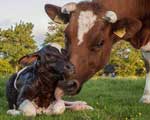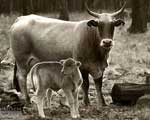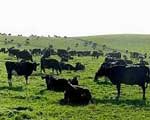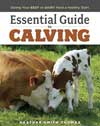Picture Credit score: Rachel Kramer
With calving season rapidly approaching for a lot of farmers within the Northern Hemisphere, it’s a good time to take a look at among the strongest preventative measures for making your spring calving season extra profitable.
A few of these suggestions are issues you are able to do both simply earlier than calving season begins or through the calving season itself with a purpose to make each your individual and your cows’ lives just a bit simpler. And some of the guidelines are modifications you can also make to your cow-calf program as much as 9 months earlier than calving season begins, so that is the fitting time to start planning for these modifications.
The information on this article are particularly tailor-made to farmers who haven’t but made the change to summer calving. You may study all about how one can arrange a summer season calving program on pasture here.
1. Late-Evening Cattle Feeding
Whereas calves could be born at virtually any time of day, the most important variety of calves will likely be born whereas the cattle herd is bedded down and resting, not throughout feeding time or instantly after feeding when the herd first settles right down to chew their cud. This implies you’ll be able to manipulate the time of day when nearly all of your calves will likely be born.
Change your cattle feeding time to late at night time simply earlier than you go to mattress. Throughout calving season my dad would at all times fireplace up the feed wagon lengthy after our personal dinnertime, after which streak to mattress for just a few quiet hours of sleep.
Feeding the cows late at night time as a substitute of through the day will trigger extra of the calves to be born through the daylight when temperatures are hotter, when you do not require a flashlight to do your herd checks, and when vets do not have to be shaken off the bed if there’s an issue you’ll be able to’t resolve by yourself. It additionally means you simply would possibly be capable to get a little bit of sleep between herd checks at night time.
2. Physique Circumstances BEFORE Calving Begins
Ensure that your cow’s body conditions are between 5 and seven at calving, ideally 7, BEFORE calving season begins. This helps not solely with colostrum manufacturing, however that is additionally the KEY to making sure excessive fertility charges within the following breeding season.
3. Use a Scours Vaccine on the Cows BEFORE Calving
Scours is without doubt one of the main deadly calf ailments in most spring calving herds. Use a scours vaccine, often administered as much as 16 weeks earlier than calving, with a booster shot just a few weeks earlier than calving. Timing varies by product and whether or not it was utilized in earlier years, so discuss to your vet! An oz of vaccine… want I say extra?
4. Pine Timber and Pregnant Cattle Do not Combine
When pregnant cows and heifers eat pine needles, they may abort their calves. Whereas cattle have a tendency to go away pine bushes alone through the grazing season since they’ve loads of grass to maintain their consideration, through the winter bored cows will nibble at something inexperienced that catches their consideration whereas they look forward to the subsequent go of the feed truck. So do not maintain pregnant cows in fields or pens containing pine bushes. And if a pine tree falls over, get it out of the pen ASAP earlier than the cows strip the branches of needles!
5. Calving Difficulties = Automated CULL
Any cow or heifer that has ANY problem calving (even an easy assisted calving) – write down her quantity and CULL her (do not rebreed her) and make it possible for her calves are equally excluded from alternative heifer or alternative bull herds. No exceptions!
You needn’t cull her instantly – she will nonetheless increase her calf first – however do not rebreed her and let her calve once more. It is the one technique to implement easy-calving genetics in your herd!
6. Breed Heifers to an Simple-Calving, Small-Framed Breed
First calf heifers are probably the most susceptible to calving difficulties due to their smaller measurement. Many industrial ranchers will due to this fact breed their alternative heifers with a smaller-framed lower-birthweight easy-calving breed.
On my mother and father’ ranch we at all times used purebred Angus bulls on the alternative heifers (it was a industrial Simmental-Hereford-Angus combined breed industrial herd). Many Holstein dairy farmers will use Highland Cattle bulls for a similar function (although it stays considerably of a thriller precisely how the little Highland bulls handle the duty with tall Holsteins with out the assistance of a footstool). Some producers even use Dexter bulls for his or her heifer breeding program.
7. Get a devoted Calf Puller
Get a correct calf puller the one proven within the image under, and learn to use it.
(Disclosure: I get commissions for purchases made utilizing Amazon hyperlinks in my publish.)
Get your vet to advocate their favourite calf puller, and get them to provide you a lesson. You may exert an amazing quantity of pressure and do irreparable injury to your cows for those who use it incorrectly, however it’s a completely VITAL device within the spring calving toolbox.
Do not reduce corners and attempt to use a come-along to drag calves if hand-pulling does not work. The angle of pull utilizing a come-along is fallacious so that you dramatically enhance the possibilities of killing or severely injuring each cow and calf whereas utilizing a come-along as a substitute of a correct calf puller.
8. Construct a Calving Field
Have a heat dry place prepared within the barn for sick or chilled calves. Take into account constructing a devoted “calving field” for severely chilled or severely unwell calves. A calving field is solely a small insulated room with a warmth lamp and thick straw for warming up calves.
Find out how to construct a calving field: consider a calving field as an over-sized doghouse, constructed with plywood and insulated partitions. Hold a warmth lamp from the ceiling of the field as the warmth supply, and put thick straw on the ground. The calving field ought to have a door to maintain the warmth in, however be certain that it isn’t hermetic – it is a small house that wants oxygen to breathe! Additionally, put a plexi-glass window within the calving field door so you’ll be able to test on the calf with out having to crawl inside each time.
Ensure that it’s giant sufficient for a minimum of 2-3 calves plus room so that you can crawl inside to manage bottled milk, colostrum, or a abdomen tube. It ought to have sufficient headroom so you’ll be able to squat comfortably inside with out burning your self on the warmth lamp each time you crawl inside.
Most farmers wish to maintain it within the barn so the cow could be stored close by to make it handy to take the calf to the cow for milk, or so the cow can simply be milked if the calf is so weak that you could feed colostrum or milk by bottle or abdomen tube.
9. Break up Heifers and Second Calf Heifers from the Essential Herd
Heifers and second calf heifers have extra calving difficulties than mature cows. And they’re much more nutritionally susceptible. In a spring calving program it’s due to this fact good apply to maintain heifers and second calf heifers separate from the primary cow herd even within the months earlier than calving begins in order that they needn’t compete with the mature cows for entry to the feed bunk and to allow them to get further feed dietary supplements or a greater high quality feed ration so guarantee their our bodies are in high situation earlier than calving begins.
And as soon as calving begins, they need to proceed to be stored separate a minimum of till they calf to allow them to be monitored extra intently for calving difficulties. Ideally, their calving pen must be absolutely the closest to the barn since they’re the age-group that’s most certainly to wish help and the most certainly to be nervous and flighty if you must attempt to get them into the barn to assist pull a calf.
10. Calving Pens must be Straight Adjoining to the Barn
Calving pens must be immediately adjoining to the barn, with straightforward gate layouts and easy entry so it’s straightforward to intervene if crucial. Nothing is extra irritating than shedding a calf just because you’ll be able to’t get a flighty cow into the barn fast sufficient.
11. Break up Calved Cows from Uncalved Cows
Take away cows which have calved from the un-calved herd. There are various causes for this:
- It makes it a lot simpler to watch cows and spot new calves within the un-calved cow herd.
- It makes tagging and calf processing simpler as a result of the brand new calves are straightforward to search out. Tag and course of whereas transferring new cow-calf pairs to the post-calving pen.
- It lets you feed totally different feed rations to deal with altering dietary wants after calving.
- It prevents pointless calf stealing – cows calving in feed pens are susceptible to stealing one another’s calves if they’re nearing calving and bedded down in shared bedding areas. (That is typically not a difficulty when calving through the summer season on rising pasture).
Some individuals with bigger cattle herds even go the additional step of making a devoted calving pen only for cows which can be nearing calving, which is consistently being refilled from the primary herd as further cows begin displaying indicators of approaching their due date.
12. Hold New child Cow-Calf Pairs Separate for 1-3 days
After calving, transfer the brand new cow-calf pair right into a separate “new child calf pen” with different new cow-calf pairs. They need to stay right here for 1-3 days, near the barn, to permit for additional monitoring and well being checks, and to supply a distraction-free setting through the essential pair bonding stage between cow and calf.
As soon as the calf seems sturdy and wholesome, the cow-calf pair could be moved on to the subsequent pen…(see the subsequent step under)…
13. Break up Calves by Age Group
Separate cow-calf pairs into totally different herds primarily based on calf age from the time they’re born till the cattle are launched onto pasture at the start of the rising season. In different phrases, create new teams of cow-calf pairs each two to a few weeks (after we had been nonetheless spring calving, we often cut up the herd into two teams, with calves born within the first 21 days of the 42-day calving season within the first group, and calves born within the second 21 days within the second group).
Splitting cow-calf pairs into calf-age-groups is a approach of quarantining illness transmission. Calf vulnerability to post-calving ailments like scours, pneumonia, or coccidiosis tends to rise or fall relying on calf age. Because the older calves grow to be vulnerable to scours just a few weeks after calving, calves within the youthful group are usually not uncovered to the illness. Likewise, as soon as the calves get stronger, the older teams will not be re-exposed to the illness by way of contact with youthful calves which can be nonetheless going by way of their most susceptible stage.
Confidently, you would possibly even handle to limit outbreaks to just one group for those who get a nasty illness outbreak.
14. Quarantine, Quarantine, Quarantine
Have a devoted sick pen for sick calves so you’ll be able to take away sick calves (together with their moms) from the remainder of the herd as quickly as doable. Quarantine is the easiest way to forestall transmission to different calves. It additionally makes it simpler to search out and deal with calves for ongoing therapy.
15. Keep away from Contaminated Floor
If you happen to’ve had scours or coccidiosis in your farm in earlier years, if doable attempt to keep away from utilizing these pens/fields throughout moist months through the first few months of the calves lives. The micro organism accountable for these malicious ailments can stay within the soil for years, ready for a brand new host. The moist muddy climate throughout spring calving are the right situations for them to spring again to life.
16. Cattle Bedding Piles = Much less Calves Born in a Snowbank
Calving cows want bedding to cut back the possibility of calves being born in a snowbank or mud puddle (some inevitably nonetheless will, however each bit helps). It additionally helps if the calving space is on nicely drained soil, freed from puddles (location, location, location!).
17. Cattle Bedding Piles = Cleaner Udders
Cow-calf pairs ought to have clear bedding (contemporary straw or sawdust) each couple of days to maintain udders clear – soiled udders are a number one reason behind illness transmission in a spring calving herd.
18. Construct Calf Sheds
Calf sheds are a well-liked technique for offering further heat bedding websites for the calves out of the wind and rain. They need to, nevertheless, have low boards blocking the entry in order that solely calves, however not cows, can step inside. The straw inside these calf sheds must be modified recurrently (and/or manure eliminated) in order that calves do not lay in manure (oral-fecal transmission is the primary reason behind illness transmission amongst younger calves). That is particularly vital when you have any sick calves within the herd. Throughout extreme illness outbreaks these calf sheds can grow to be dying traps if the contaminated manure will not be eliminated and the straw refreshed a number of occasions per day.
19. Get the Cattle Feed out of the Muck
As talked about earlier, oral-fecal transmission is the first approach that ailments are unfold amongst your calves. Feed areas which can be reused will inevitably have cows and calves poop and mattress down in them, then contemporary feed is poured on high – and presto, calves nosing concerning the feed space will likely be uncovered. If floor feeding, use a contemporary location on clear contemporary floor with every new feeding.
Floor feeding in clear websites can nonetheless be an issue if illness micro organism are within the soil from scours or coccidiosis or different illness outbreaks from earlier years. It’s possible you’ll need to take a look at feeding in feed bunks or feeders that get the feed up off the bottom.
Feed bunks and hay feeders generally is a downside supply as nicely although. They have an inclination to grow to be surrounded by mud and manure, which results in soiled udders which the calves suck, and presto, contemporary illness stress within the calf herd. Moreover, feed bunks and hay feeders are inclined to both be too tall for calves to achieve or depart little room for calves, so they’re left to nibble at feed that falls down out of the feeders and into the muck.
If utilizing cell feeders, transfer them typically to contemporary floor.
If utilizing everlasting feed bunks, be certain that they’re positioned on well-drained excessive floor and recurrently scrape away manure construct up.
Many feed bunks are constructed on concrete pads, however the space behind the cow the place the pad ends is commonly a large downside due to manure construct up, plus the nice and cozy manure thaws the bottom the place the concrete ends. This leaves calves wading by way of chin deep mud and cows dragging udders by way of the muck with a purpose to clamber up onto the concrete pad.
Ideally the concrete pads must be double the size of your cows (most are usually solely constructed simply lengthy sufficient for the again ft of the cow to face on the pad). A double-wide pad helps to include all of the manure that’s produced throughout feeding so it may be recurrently scraped away with a tractor. This in flip helps cut back the bottom thawing on the finish of the concrete pad. The tip of the concrete pad the place the cows step off into the paddock must be nicely drained and have well-packed coarse gravel to assist it stand as much as the trials of the feed season.
20. Purchase some Ice Cleats
Purchase
a pair of ice cleats that match over your winter/rubber boots. Or get a pair of caulk logger’s boots (with the spikes within the boot sole). They are going to be your greatest buddy subsequent time you attempt to deliver a cow into the barn on icy floor, or worse, attempt to outrun an overprotective cow on icy floor.
21. Take A Protect To Work
Overprotective cows generally is a severe hazard throughout spring calving while you soar on their calves to tag or course of them after calving. In actuality, you’ll be able to’t actually blame the cow for doing her job. Calves born on open vary or on summer season pasture want that form of aggressive protectiveness, however that turns into just a little laborious to recollect while you’re the one with a goal painted in your brow.
A easy trick to make your life just a bit safer: construct your self a plywood protect (i.e. 2’6″ x 4′ x 1/2″) with a few handles bolted on the again. Take it with you when tagging and processing calves within the paddock. It provides to your visible bulk, it is much less threatening than when a cow can see your predatory eyes, and if issues flip ugly it gives an enormous diploma of additional safety if there is a protect separating you from a cow’s head, no matter whether or not or not she’s obtained horns.
I realized this trick whereas working with musk oxen on the Giant Animal Analysis Station in Fairbanks, Alaska, however discovered it simply as helpful working with horned cattle like Highland Cattle in addition to common de-horned or polled cattle like these in my mother and father’ industrial cattle herd.
22. Change to SUMMER CALVING
I’ve undoubtedly saved my favourite technique for final – change to summer season calving!
Whereas efficiently navigating a spring (or winter) calving season will depend on all these sophisticated and costly administration strategies listed above, the overwhelming majority of calving-related issues merely do not exist when calving on pasture through the rising season.
Demise losses, calving difficulties, advanced herd administration, tagging, processing, sophisticated cattle vitamin methods, and calf ailments all merely soften away when you efficiently change your herd over to calving through the rising season. Even the variety of cows requiring help throughout calving dramatically goes down while you change to calving on pasture in the summertime.
Calf dying losses in most conventional spring calving applications (as a result of calving issues, nonetheless births, and subsequent calf ailments) are inclined to vary between 7-15%, even in case you are working your tail off, checking cows each 2 hours, 24 hours/day, all through the calving season, and doing 2x every day herd checks by way of your calves to identify and deal with for calf ailments.
As soon as we switched our herd to summer season calving, calf dying losses (calving + post-calving ailments) dropped to lower than 1.5% (calving out a herd of as much as 400 cow/calf pairs). We stopped tagging and processing calves at delivery. We stopped checking at night time. We diminished herd checks to as soon as per day to coincide with the every day grazing rotation. Publish-calving ailments all however disappeared. Scours, pneumonia, and coccidiosis turned a distant reminiscence. And the barn and the calving field had been left to gather mud subsequent to the rusting calf puller.
Switching to summer season calving takes appreciable pre-planning and requires a rethink of your cattle advertising and marketing program, however the payback is appreciable and the standard of each your and your cows’ lives will likely be dramatically improved.
To study extra about making the change so summer season calving, take a look at these articles:
 |
The Benefits of Calving on Pasture – Calving through the rising season is without doubt one of the strongest instruments to grow to be a low-cost cow-calf producer. This text explains simply why calving on pasture through the rising season is so a lot better than calving at every other time of yr. |
|
The Ideal Calving Date for Raising Cattle – This text will allow you to select the exact calving date that may have probably the most optimistic influence in your grazing program. |
|
|
Calving on Pasture – Calving through the rising season means calving on pasture as a substitute of in a winter feed pen. That modifications all the things! This text explains how one can handle your calving program on pasture within the midst of a every day pasture rotation. |
Extra Spring Calving Ideas:
For extra tips about how one can survive a spring calving season, take a look at Healther Smith Thomas’ guide: The Essential Guide to Calving: Giving Your Beef or Dairy Herd a Healthy Start.
Whereas it doesn’t cowl the specifics of how one can arrange your summer season calving program on pasture (you’ll be able to study extra about that in my Calving on Pasture article), it gives invaluable tips about a variety of calving points, together with directions on how one can acknowledge calving cows, pointers for when to intervene and how one can acknowledge the indicators of a cow that wants help throughout calving, directions for how one can help a cow throughout supply, and recommendation for how one can take care of a variety of post-calving ailments that may have an effect on new child calves.
Share your favourite calving season suggestions and methods!
What calving methods do you employ to make your spring calving season simpler? And the way has your calving season modified when you have already made the change to calving on pasture? Share your experiences within the Feedback part under.
…
Thanks for taking the time to learn my article. I hope you have loved it. If you would like to be notified once I launch future cattle farming articles, join my email notifications or comply with me on Facebook or Twitter.
Trending Merchandise

ZuPreem FruitBlend Bird Food, Bird Feed Pelle...

ZuPreem Sensible Seed Bird Food, Parakeet, Bu...

Kaytee Forti-Diet Egg-Cite Parakeet Pet Bird ...

Best Nest Wellness Mama Bird Probiotics ̵...

Kaytee Fiesta Macaw Food, Nutritious and Fun ...

Pet Eye Cream Health for Dogs, Cats, Cattle, ...








